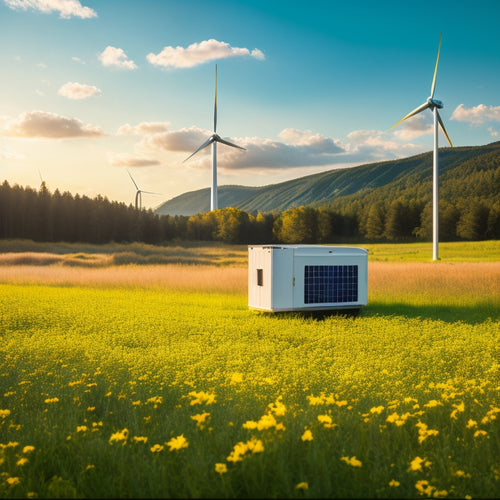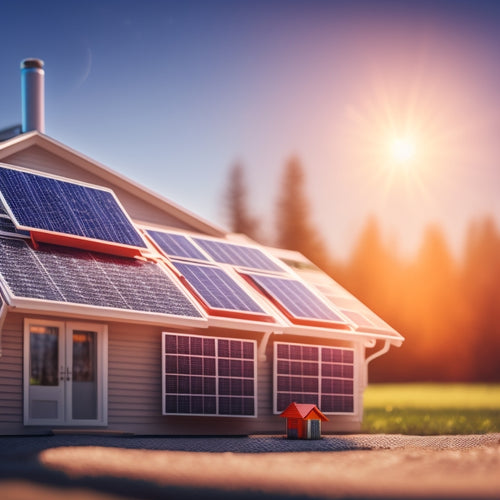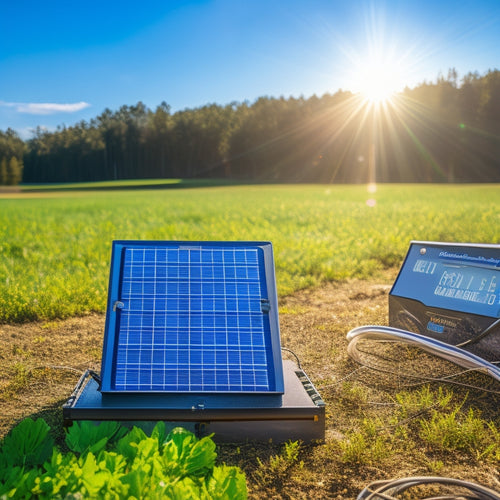
Design Your Own Solar System
Share
As you design your own solar system, consider your unique energy needs and sustainability goals. Choose from monocrystalline, polycrystalline, or thin-film panels, and decide on a battery storage system, such as lead-acid or lithium-ion batteries. Supplemental energy sources like wind turbines and fuel cells can also be integrated. Next, optimize your system's renewable energy ratio and design to decrease energy costs and carbon emissions. Select efficient solar panels, incorporate energy storage solutions, and optimize system configuration to minimize losses. By personalizing your energy mix, you'll be well on your way to a customized solar system that meets your specific needs - and there's more to uncover as you fine-tune your sustainable energy solution.
The Essentials
- Determine your renewable energy ratio to balance sustainability and energy independence with a custom mix of solar, wind, and fuel cells.
- Select efficient solar panels, optimized system design, and storage solutions to minimize energy waste and maximize performance.
- Implement maximum power point tracking (MPPT) methods, such as perturb and observe or incremental conductance, to optimize energy harvesting.
- Assess your energy consumption by identifying appliance wattage, daily usage, and peak hours to accurately size your solar array and storage needs.
- Optimize inverter efficiency, with a focus on higher efficiency rates, to maximize the conversion of DC power to usable AC power and increase energy harvest.
Customize Your Energy Mix
You'll need to select from a range of energy source options, including solar panels, wind turbines, and energy storage systems, such as home battery storage solutions, to create a customized energy mix that suits your specific needs.
By incorporating these solutions, you can reduce your reliance on the grid and lower your electricity bills. The renewable energy ratio, which represents the percentage of your energy needs met by renewable sources, will also play a critical role in shaping your energy strategy.
Energy Source Options
Several energy sources are at your disposal to power your solar system. You'll need to decide which ones to use, and in what combination, to meet your energy needs.
When it comes to solar panel types, you have options. Monocrystalline silicon panels offer high efficiency but come at a higher cost. Polycrystalline silicon panels are more budget-friendly but slightly less efficient. Thin-film panels are the most affordable option, but they also have the lowest efficiency.
By integrating a battery storage system into your solar setup, you can release the full potential of renewable energy and create a more sustainable, dependable, and cost-effective power solution Solar Energy Storage Solutions. This allows you to store excess energy generated during the day to use at night or during power outages.
Energy storage is another significant aspect to contemplate. You'll need a battery system to store excess energy generated during the day for use at night or during power outages. You can choose from lead-acid, lithium-ion, or other types of batteries, each with their own advantages and disadvantages.
You may also think about supplementing your solar power with other energy sources, such as wind turbines or fuel cells. This will guarantee a reliable energy supply, even on cloudy days or during periods of low sunlight.
Renewable Energy Ratio
Your solar system's energy mix is a delicate balance of power sources, and the Renewable Energy Ratio is an essential factor in determining this mix. This ratio calculates the percentage of renewable energy in your system, guaranteeing you meet your sustainability practices and energy independence goals. A higher ratio indicates a greater reliance on green technology, reducing your carbon footprint and environmental impact.
By integrating solar panels, a charge controller, inverter, and battery storage into a single, compact unit, such as an All in One Solar Power System, you can simplify the shift to renewable energy and guarantee a steady power supply even when the grid is down. Additionally, incorporating innovative solar solutions can increase your utility savings and reduce your reliance on traditional power sources.
A well-designed system with a high Renewable Energy Ratio can greatly decrease your energy costs and carbon emissions. As you customize your energy mix, prioritize renewable energy sources to achieve a cleaner, more sustainable energy profile. With a balanced Renewable Energy Ratio, you'll be well on your way to energy independence and a reduced environmental impact.
Zero Energy Waste Guarantee
You'll want to make sure your solar system design incorporates waste reduction strategies to minimize energy losses and maximize efficiency.
By implementing measures like enhanced panel orientation and advanced inverter technologies, you can reduce waste and generate more usable energy.
When designing your solar system, consider the principles of planetary design solar system design to make sure the best energy harvesting occurs.
Additionally, incorporating smart grid integration and advanced energy storage systems, such as those used in space system planning, can further reduce energy waste.
To achieve a zero energy waste guarantee, you'll need to combine these strategies with energy efficiency measures, such as smart grid integration and advanced energy storage systems.
Waste Reduction Strategies
In tandem with the pursuit of zero energy waste, a strong waste reduction strategy is essential to achieving a sustainable solar system design.
You'll need to implement a multi-faceted approach that tackles waste generation at every stage. Start by conducting thorough waste audits to identify areas of inefficiency and opportunities for improvement.
Implement composting techniques and recycling initiatives to minimize organic waste and maximize resource recovery. Specify sustainable materials and eco-friendly practices in your design, from construction to operation.
Opt for green transportation solutions and encourage responsible consumption among users. Upcycling projects can also breathe new life into discarded materials, further reducing landfill waste.
By adopting a circular economy mindset, you'll be able to design a solar system that not only generates clean energy but also minimizes its environmental footprint.
Through careful planning and execution, you can create a truly waste-free solar system that embodies the principles of freedom and sustainability.
Energy Efficiency Measures
Optimization of energy efficiency is crucial to achieving a zero energy waste guarantee in your solar system design. By implementing efficient energy measures, you'll minimize energy losses and maximize your system's overall performance.
First, select the most efficient solar panel types for your system. Monocrystalline panels, for instance, offer higher efficiencies than polycrystalline panels.
Next, consider incorporating energy storage solutions, such as batteries, to store excess energy generated during the day for use during the night or on cloudy days. This guarantees a stable and reliable energy supply, reducing waste and increasing your system's autonomy.
Additionally, optimize your system's configuration to minimize energy losses due to temperature, shading, and wiring. Properly sizing your system's components, such as inverters and charge controllers, will also help reduce energy waste.
Maximum Power Point Tracking
You'll need to optimize energy harvesting by identifying the maximum power point (MPP) of your solar panel array, as it varies with temperature and irradiance.
To achieve this, you'll employ voltage regulation methods that continuously track and adapt to the MPP, ensuring maximum energy extraction.
For instance, an efficient home solar power systems can greatly benefit from MPPT systems.
By leveraging advanced MPPT algorithms, you can minimize energy losses and maximize your solar array's output power.
Optimizing Energy Harvest
By carefully tuning your solar panel's operating point, you can squeeze out every last watt of available power.
This is where enhancing energy harvest comes into play. To maximize your energy output, you'll need to evaluate factors like solar panel orientation and shading analysis.
Proper orientation guarantees your panels receive the ideal amount of sunlight, while shading analysis helps identify areas where obstructions might reduce energy production.
Voltage Regulation Methods
Now that you've optimized your solar panel's operating point, it's time to regulate the voltage to guarantee you're utilizing the maximum power possible. Maximum Power Point Tracking (MPPT) is an essential component in achieving voltage stability and mitigating voltage fluctuations. This secures power quality and efficient load management. To achieve this, you'll need to configure your inverter settings to match your system's performance requirements.
Here's a comparison of popular MPPT methods:
| Method | Advantages | Disadvantages |
|---|---|---|
| Perturb and Observe | Simple implementation, low cost | May oscillate around MPP, affecting system performance |
| Incremental Conductance | Fast tracking, high accuracy | Complex implementation, higher cost |
| Constant Voltage | Simple, low-cost, and efficient | May not track MPP accurately, affecting energy storage |
| Fractional Open-Circuit Voltage | Fast tracking, high accuracy | May not be suitable for grid interaction, requires surge protection |
When selecting an MPPT method, consider factors like battery compatibility, grid interaction, and system performance requirements. By choosing the right method, you'll guarantee your solar system operates at its maximum potential, providing you with the freedom to utilize renewable energy efficiently.
Assess Your Energy Consumption
You need to determine how much energy your system will require to power your appliances and devices.
To do this, you'll create an energy usage breakdown, identifying the wattage and daily usage hours of each item.
For instance, consider the energy storage capacity you'll need to power your electric vehicle charging station residential solar energy or other high-energy devices.
This will give you your daily power requirements, a critical input for designing your solar system.
Energy Usage Breakdown
Evaluating your energy consumption is an essential step in designing your own solar system, as it allows you to determine your energy needs and identify areas for improvement. By understanding your energy usage breakdown, you can optimize your solar system's performance and reduce your reliance on the grid.
To assess your energy consumption, you'll need to conduct an energy audit. This involves tracking your energy usage patterns over a period of time to identify peak usage hours, energy-intensive appliances, and opportunities for energy efficiency improvements. Here's a breakdown of your energy consumption patterns:
| Appliance | Daily Usage (hours) | Energy Consumption (kWh) |
|---|---|---|
| Refrigerator | 24 | 1.5 |
| Air Conditioning | 8 | 2.0 |
| Lighting | 12 | 0.5 |
| Electric Water Heater | 4 | 1.0 |
Daily Power Requirements
With your energy consumption patterns in hand, it's time to calculate your daily power requirements. This involves determining your total daily energy demand, also known as your solar load. To do this, you'll need to analyze your energy audit results, identifying usage trends and peak hours when your power demand is highest.
This information will help you size your solar array and energy storage system accurately.
Consider your lifestyle impacts on energy consumption, such as working from home or running a home office. These factors can increase your power demand during the day.
Your daily power requirements will also influence your off-grid solutions, as you'll need to guarantee you have sufficient energy storage to meet your needs during periods of low sunlight or at night.
Higher Inverter Efficiency Rate
You'll want to optimize your solar system's inverter efficiency rate to maximize energy harvest.
A higher efficiency rate guarantees that more of the DC power generated by your solar panels is converted to usable AC power.
Maximizing Energy Harvest
In designing your solar system, optimizing inverter efficiency is crucial to maximize energy harvest. A higher inverter efficiency rate guarantees that more of the energy generated by your solar panels is converted into usable power for your home or business. To achieve this, you'll need to take into account various factors, including solar panel orientation and energy storage solutions.
| Inverter Efficiency | Energy Harvest | Annual Savings |
|---|---|---|
| 95% | 23,000 kWh | $3,450 |
| 97% | 24,500 kWh | $3,675 |
| 99% | 26,000 kWh | $3,900 |
| 100% | 27,500 kWh | $4,125 |
As shown in the table above, even a 1% increase in inverter efficiency can result in significant annual savings. By selecting high-efficiency inverters and optimizing your solar panel orientation, you can maximize your energy harvest and reduce your reliance on the grid. Additionally, incorporating energy storage solutions, such as batteries, can help you store excess energy generated during the day for use during periods of low sunlight or at night. By taking these steps, you can design a solar system that provides you with the freedom and independence you desire.
Frequently Asked Questions
Do I Need a South-Facing Roof for Solar Panels to Work?
You don't necessarily need a south-facing roof for solar panels to work, but ideal solar panel orientation and roof angle considerations are essential; a west- or east-facing roof can still generate significant energy, although with slightly reduced efficiency.
Can I Add More Panels to My System in the Future?
Just like a skilled builder adds wings to a castle, you can expand your solar setup in the future, ensuring system compatibility and seamless integration, allowing you to utilize more power and freedom as your energy needs evolve.
Will My Solar System Work During a Power Outage?
During a power outage, you'll stay energized with a battery backup system, ensuring energy independence and uninterrupted power supply, so you can keep living life on your terms, free from grid reliance.
How Long Does It Take to Install a Solar System?
As you're waiting for the lights to come back on, you're probably wondering how long it'll take to get your solar system up and running. The installation timeline depends on installation factors like system size, roof complexity, and permits, but typically takes 2-5 days.
Are Solar Panels Damaged by Hail or Heavy Snow?
You're right to wonder if solar panels can withstand harsh weather; rest assured, most modern panels are built with hail resistance in mind, and snow accumulation is rarely a concern, as the panels' angle allows snow to slide off easily.
Final Thoughts
You've successfully designed your own solar system, customized to your energy needs and preferences. With a personalized energy mix, zero energy waste guarantee, and maximum power point tracking, you're guaranteed a reliable and efficient renewable energy source. Evaluating your energy consumption has allowed you to optimize your system for maximum output. Significantly, did you know that a mere 1% increase in inverter efficiency rate can translate to a 10% increase in energy production? This highlights the importance of precision engineering in utilizing the full potential of solar energy.
Related Posts
-

Sustainable and Eco-Friendly Generators for a Reduced Carbon Footprint
Sustainable and eco-friendly generators are perfect for cutting your carbon footprint and increasing energy efficienc...
-

A Beginner's Guide to Navigating the Solar Investment Tax Credit
You're eligible to claim a significant Solar Investment Tax Credit (ITC) of 30% of total installation costs, but mane...
-

Choosing the Right Solar Power Charge Controller
Choosing the right solar power charge controller is crucial for maximizing energy efficiency and extending battery li...


